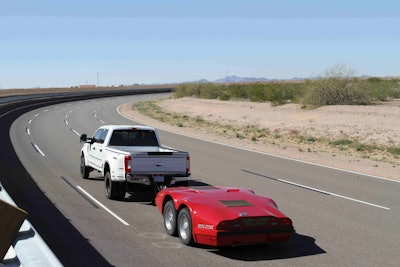
Ford engineers announced today that the new F-Series Super Duty is so powerful that it needed new equipment to simulate traveling up steep mountain grades to ensure that it meets expectations.
Traditionally, a dynamometer sled is attached to the vehicle hitch and pulled behind it. Ford engineers reported that the old-style dynamometer did not challenge the power of the latest Super Duty, so Ford set out to find a new, stronger dyno sled to test the vehicle’s mountain climbing capability limits.
“The new Super Duty is really impressive,” said Jim Sumner, Ford product development engineer. “In more than 25 years of doing this work, we used the same dyno, which did the job, but the new truck is so powerful we needed new equipment to test out its capability. The fact that even under full load, Super Duty didn’t have any trouble at all is a testament to just how capable this new truck is.”
HWT Related: Ford truck customers witness behind the scenes tests
The dyno simulates steep grades by providing pull against the vehicle, using a brake limiter—a series of electric coils wired together that are energized, acting like a large magnet. This drawbar pull against the truck mimics the effects of gravity while driving up an incline.
 While being towed by a Super Duty truck, Ford’s new dyno sled simulates climbing steep hills.
While being towed by a Super Duty truck, Ford’s new dyno sled simulates climbing steep hills.The new dyno is capable of a maximum drawbar pull of 5,620 pounds – a 181 percent increase compared with the 2,000 pounds from the previous dyno, allowing the new setup to simulate steeper hills. A common simulated grade used for testing is approximately 7 percent, but the new towing dynamometer used at Ford’s Arizona Proving Grounds can simulate up to a 30 percent grade.
“Any test engineer in North America knows about Davis Dam,” said Sumner. “It’s a demanding hill going from sea level to more than 3,000 feet in 11.2 miles, and is an ideal location to test towing capability. With this dyno, we can test the all-new Super Duty on that hill – but from right here on the level surface of our Arizona Proving Grounds.”
The equipment allowed Ford engineers to virtually test the new Super Duty on Davis Dam and Townes Pass without leaving the proving grounds. Testers upload the profile of the hills to the dyno and it adjusts to the correct grade, allowing for the truck to be tested in a variety of conditions to ensure performance regardless of environment.
Townes Pass, the other hill engineers use for testing, is approximately 16 miles long, featuring an average grade of 5.1 percent and a maximum grade of 10.1 percent.
Davis Dam is so effective for testing vehicle capabilities that the Society of Automotive Engineers incorporated the grade of the hill into its test standards. Being able to test on this grade without having to make the trip to the real hill in Bullhead City, Arizona, expedites testing, and helps Ford engineers ensure that the new Super Duty will meet customer expectations.








